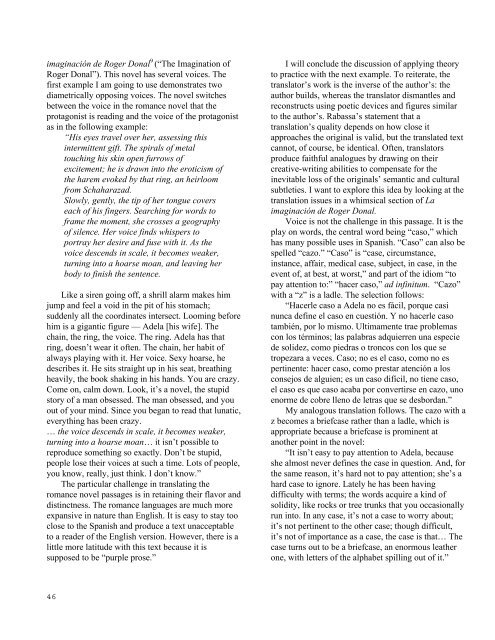their - The University of Texas at Dallas
their - The University of Texas at Dallas
their - The University of Texas at Dallas
Create successful ePaper yourself
Turn your PDF publications into a flip-book with our unique Google optimized e-Paper software.
imaginación de Roger Donal 9 (“<strong>The</strong> Imagin<strong>at</strong>ion <strong>of</strong><br />
Roger Donal”). This novel has several voices. <strong>The</strong><br />
first example I am going to use demonstr<strong>at</strong>es two<br />
diametrically opposing voices. <strong>The</strong> novel switches<br />
between the voice in the romance novel th<strong>at</strong> the<br />
protagonist is reading and the voice <strong>of</strong> the protagonist<br />
as in the following example:<br />
“His eyes travel over her, assessing this<br />
intermittent gift. <strong>The</strong> spirals <strong>of</strong> metal<br />
touching his skin open furrows <strong>of</strong><br />
excitement; he is drawn into the eroticism <strong>of</strong><br />
the harem evoked by th<strong>at</strong> ring, an heirloom<br />
from Schaharazad.<br />
Slowly, gently, the tip <strong>of</strong> her tongue covers<br />
each <strong>of</strong> his fingers. Searching for words to<br />
frame the moment, she crosses a geography<br />
<strong>of</strong> silence. Her voice finds whispers to<br />
portray her desire and fuse with it. As the<br />
voice descends in scale, it becomes weaker,<br />
turning into a hoarse moan, and leaving her<br />
body to finish the sentence.<br />
Like a siren going <strong>of</strong>f, a shrill alarm makes him<br />
jump and feel a void in the pit <strong>of</strong> his stomach;<br />
suddenly all the coordin<strong>at</strong>es intersect. Looming before<br />
him is a gigantic figure — Adela [his wife]. <strong>The</strong><br />
chain, the ring, the voice. <strong>The</strong> ring. Adela has th<strong>at</strong><br />
ring, doesn’t wear it <strong>of</strong>ten. <strong>The</strong> chain, her habit <strong>of</strong><br />
always playing with it. Her voice. Sexy hoarse, he<br />
describes it. He sits straight up in his se<strong>at</strong>, bre<strong>at</strong>hing<br />
heavily, the book shaking in his hands. You are crazy.<br />
Come on, calm down. Look, it’s a novel, the stupid<br />
story <strong>of</strong> a man obsessed. <strong>The</strong> man obsessed, and you<br />
out <strong>of</strong> your mind. Since you began to read th<strong>at</strong> lun<strong>at</strong>ic,<br />
everything has been crazy.<br />
… the voice descends in scale, it becomes weaker,<br />
turning into a hoarse moan… it isn’t possible to<br />
reproduce something so exactly. Don’t be stupid,<br />
people lose <strong>their</strong> voices <strong>at</strong> such a time. Lots <strong>of</strong> people,<br />
you know, really, just think. I don’t know.”<br />
<strong>The</strong> particular challenge in transl<strong>at</strong>ing the<br />
romance novel passages is in retaining <strong>their</strong> flavor and<br />
distinctness. <strong>The</strong> romance languages are much more<br />
expansive in n<strong>at</strong>ure than English. It is easy to stay too<br />
close to the Spanish and produce a text unacceptable<br />
to a reader <strong>of</strong> the English version. However, there is a<br />
little more l<strong>at</strong>itude with this text because it is<br />
supposed to be “purple prose.”<br />
I will conclude the discussion <strong>of</strong> applying theory<br />
to practice with the next example. To reiter<strong>at</strong>e, the<br />
transl<strong>at</strong>or’s work is the inverse <strong>of</strong> the author’s: the<br />
author builds, whereas the transl<strong>at</strong>or dismantles and<br />
reconstructs using poetic devices and figures similar<br />
to the author’s. Rabassa’s st<strong>at</strong>ement th<strong>at</strong> a<br />
transl<strong>at</strong>ion’s quality depends on how close it<br />
approaches the original is valid, but the transl<strong>at</strong>ed text<br />
cannot, <strong>of</strong> course, be identical. Often, transl<strong>at</strong>ors<br />
produce faithful analogues by drawing on <strong>their</strong><br />
cre<strong>at</strong>ive-writing abilities to compens<strong>at</strong>e for the<br />
inevitable loss <strong>of</strong> the originals’ semantic and cultural<br />
subtleties. I want to explore this idea by looking <strong>at</strong> the<br />
transl<strong>at</strong>ion issues in a whimsical section <strong>of</strong> La<br />
imaginación de Roger Donal.<br />
Voice is not the challenge in this passage. It is the<br />
play on words, the central word being “caso,” which<br />
has many possible uses in Spanish. “Caso” can also be<br />
spelled “cazo.” “Caso” is “case, circumstance,<br />
instance, affair, medical case, subject, in case, in the<br />
event <strong>of</strong>, <strong>at</strong> best, <strong>at</strong> worst,” and part <strong>of</strong> the idiom “to<br />
pay <strong>at</strong>tention to:” “hacer caso,” ad infinitum. “Cazo”<br />
with a “z” is a ladle. <strong>The</strong> selection follows:<br />
“Hacerle caso a Adela no es fácil, porque casi<br />
nunca define el caso en cuestión. Y no hacerle caso<br />
también, por lo mismo. Ultimamente trae problemas<br />
con los términos; las palabras adquierren una especie<br />
de solidez, como piedras o troncos con los que se<br />
tropezara a veces. Caso; no es el caso, como no es<br />
pertinente: hacer caso, como prestar <strong>at</strong>ención a los<br />
consejos de alguien; es un caso difícil, no tiene caso,<br />
el caso es que caso acaba por convertirse en cazo, uno<br />
enorme de cobre lleno de letras que se desbordan.”<br />
My analogous transl<strong>at</strong>ion follows. <strong>The</strong> cazo with a<br />
z becomes a briefcase r<strong>at</strong>her than a ladle, which is<br />
appropri<strong>at</strong>e because a briefcase is prominent <strong>at</strong><br />
another point in the novel:<br />
“It isn’t easy to pay <strong>at</strong>tention to Adela, because<br />
she almost never defines the case in question. And, for<br />
the same reason, it’s hard not to pay <strong>at</strong>tention; she’s a<br />
hard case to ignore. L<strong>at</strong>ely he has been having<br />
difficulty with terms; the words acquire a kind <strong>of</strong><br />
solidity, like rocks or tree trunks th<strong>at</strong> you occasionally<br />
run into. In any case, it’s not a case to worry about;<br />
it’s not pertinent to the other case; though difficult,<br />
it’s not <strong>of</strong> importance as a case, the case is th<strong>at</strong>… <strong>The</strong><br />
case turns out to be a briefcase, an enormous le<strong>at</strong>her<br />
one, with letters <strong>of</strong> the alphabet spilling out <strong>of</strong> it.”<br />
46

















